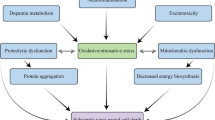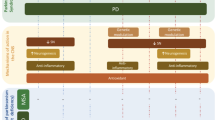Abstract
Parkinson’s disease (PD) is characterized by progressive degeneration of dopaminergic neurons in the nigrostriatal system and dopamine (DA) depletion in the striatum. The most popular therapeutic medicine for treating PD, 3-(3,4-Dihydroxyphenyl)-l-alanine (L-DOPA), has adverse effects, such as dyskinesia and disease acceleration. As superoxide (·O2 −) and hydroxyl radical (·OH) have been implicated in the pathogenesis of PD, free radical scavenging and antioxidants have attracted attention as agents to prevent disease progression. Rodents injected with 6-hydroxydopamine (6-OHDA) intracerebroventricularly are considered to be a good animal model of PD. Zingerone and eugenol, essential oils extracted from ginger and cloves, are known to have free radical scavenging and antioxidant effects. Therefore, we examined the effects of zingerone and eugenol on the behavioral problems in mouse model and on the DA concentration and antioxidant activities in the striatum after 6-OHDA administration and L-DOPA treatment. Daily oral administration of eugenol/zingerone and injection of L-DOPA intraperitoneally for 4 weeks following a single 6-OHDA injection did not improve abnormal behaviors induced by L-DOPA treatment. 6-OHDA reduced the DA level in the striatum; surprisingly, zingerone and eugenol enhanced the reduction of striatal DA and its metabolites. Zingerone decreased catalase activity, and increased glutathione peroxidase activity and the oxidized L-ascorbate level in the striatum. We previously reported that pre-treatment with zingerone or eugenol prevents 6-OHDA-induced DA depression by preventing lipid peroxidation. However, the present study shows that post-treatment with these substances enhanced the DA decrease. These substances had adverse effects dependent on the time of administration relative to model PD onset. These results suggest that we should be wary of ingesting these spice elements after the onset of PD symptoms.


Similar content being viewed by others
References
Kondo T (1996) Parkinson’s disease and free radicals. Mechanism of neurodegeneration and neuroprotection. Ann NY Acad Sci 786:206–216
Tolwani RJ, Jakowec MW, Petzinger GM et al (1999) Experimental models of Parkinson’s disease: insights from many models. Lab Anim Sci 49:363–371
Andrew R, Watson DG, Best SA et al (1993) The determination of hydroxydopaminea and other trace animals in the urine of Parkinsonian patients and normal controls. Neurochem Res 18:1175–1177
Glinka Y, Gassen M, Youdim MBH (1997) Mechanism of 6-hydroxydopamine neurotoxicity. J Neural Transm Suppl 50:55–66
Kumar R, Agarwal AK, Seth PK (1995) Free radical-generated neurotoxicity of 6-hydroxydopamine. J Neurochem 64:1703–1707
Kabuto H, Yokoi I, Iwata IE et al (1999) EPC-K1, a hydroxyl radical scavenger, prevents 6-hydroxydopamine-induced dopamine depression in the mouse striatum by up-regulation of catalase activity. Neurochem Res 24:1543–1548
Kabuto H, Nishizawa M, Tada M et al (2005) Zingerone [4-(4-hydroxy-3-methoxyphenyl)-2-butanone] prevents 6-hydroxydopamine-induced dopamine depression in mouse striatum and increases superoxide scavenging activity in serum. Neurochem Res 30:325–332
Kabuto H, Tada M, Kohno M (2007) Eugenol [2-methoxy-4-(2-propenyl)phenol] prevents 6-hydroxydopamine-induced dopamine depression and lipid peroxidation inductivity in mouse striatum. Biol Pharm Bull 30:423–427
Ito M, Murakami K, Yoshino M (2005) Antioxidant action of eugenol compounds: role of metal ion in the inhibition of lipid peroxidation. Food Chem Toxicol 43:461–466
Nagababu E, Lakshmaiah N (1992) Inhibitory effect of eugenol on non-enzymatic lipid peroxidation in rat river mitochondria. Biochem Pharmacol 43:2393–2400
Reddy AC, Lokesh BR (1992) Studies on spice principles as antioxidants in the inhibition of lipid peroxidation of rat liver microsomes. Mol Cell Biochem 111:117–124
Krishnakantha TP, Lokesh BR (1993) Scavenging of superoxide anions by spice principles. Indian J Biochem Biophys 30:133–134
Ogawa N (1994) Levodopa and dopamine agonists in the treatment of Parkinson’s diseases: advantages and disadvantages. Eur Neurol Suppl 34:320–328
Oberley LW, Spitz DR (1984) Assays of superoxide dismutase activity in tumor tissue. Method Enzymol 105:457–464
Aebi H (1984) Catalase in vitro. Method Enzymol 105:121–126
Lowry OJ, Rosebrough NJ, Farr AL et al (1951) Protein measurement with folin-phenol reagent. J Biol Chem 193:265–275
Dexter DT, Wells FR, Lees AJ et al (1989) Increased nigral iron content and alterations in other metal ions occurring in brain in Parkinson’s disease. J Neurochem 52:1830–1836
Ambani LM, Van Woert MH, Murphy S (1975) Brain peroxidase and catalase in Parkinson disease. Arch Neurol 32:114–118
Kish SJ, Morito C, Hornykiewicz O (1985) Glutathion peroxidase activity in Parkinson’s diseases. Neurosci Lett 58:343–346
Riederer P, Sofic E, Rausch WD et al (1989) Transition metals, ferritin, glutathione, and ascorbic acid in Parkinsonian brains. J Neurochem 52:515–520
Olanow CW (1993) A radical hypothesis for neurodegeneration. Trends Neurosci 16:439–444
Adams JD, Odunze IN (1991) Oxygen free radicals and Parkinson’s diseases. Free Radical Biol Med 10:161–169
Ogawa N, Edamatsu R, Mizukawa K et al (1993) Degeneration of dopaminergic neurons and free radicals: possible participation of levodopa. Adv Neurol 60:242–250
Ogawa N, Asanuma M, Kondo Y et al (1994) Differential effects of chronic L-DOPA treatment on lipid peroxidation in the mouse brain with or without pretreatment with 6-hydroxydopamine. Neurosci Lett 171:55–58
Cadet JL, Katz M, Jackson-Lewis V et al (1989) Vitamin E attenuates the toxic effects of intrastriatal injection of 6-hydroxydopamine (6-OHDA) in rats: behavioral and biochemical evidence. Brain Res 476:10–15
Rao BN, Rao BS (2010) Antagonistic effects of zingerone, a phenolic alkanone against radiation-induced cytotoxicity, genotoxicity, apoptosis and oxidative stress in Chinese hamster lung fibroblast cells growing in vitro. Mutagenesis 25:577–587
Calabrese V, Comelius C, Trovato A, Cavallaro M et al (2010) The hermetic role of dietary antioxidants in free radical-related diseases. Curr Pharm Des 16:877–883
Aggarwal BB, Kunnumakkara AB, Harikumar KB et al (2008) Potential of spice-derived phytochemicals for cancer prevention. Planta Med 74:1560–1569
Hasana-Ranjbar S, Larijani B, Abdollahi M (2009) A systematic review of the potential herbal sources of future drugs effective in oxidant-related diseases. Inflamm Allergy Drug Targets 8:2–10
Kundu JK, Na HK, Surh YJ (2009) Ginger-derived phenolic substances with cancer preventive and therapeutic potential. Forum Nutr 61:182–192
Acknowledgment
This study was supported by a Grant-in-Aid (No. 20500714) for Scientific Research from the Ministry of Education, Science, Culture and Sports of Japan.
Author information
Authors and Affiliations
Corresponding author
Rights and permissions
About this article
Cite this article
Kabuto, H., Yamanushi, T.T. Effects of Zingerone [4-(4-Hydroxy-3-Methoxyphenyl)-2-Butanone] and Eugenol [2-Methoxy-4-(2-Propenyl)Phenol] on the Pathological Progress in the 6-Hydroxydopamine-Induced Parkinson’s Disease Mouse Model. Neurochem Res 36, 2244–2249 (2011). https://doi.org/10.1007/s11064-011-0548-5
Received:
Revised:
Accepted:
Published:
Issue Date:
DOI: https://doi.org/10.1007/s11064-011-0548-5




